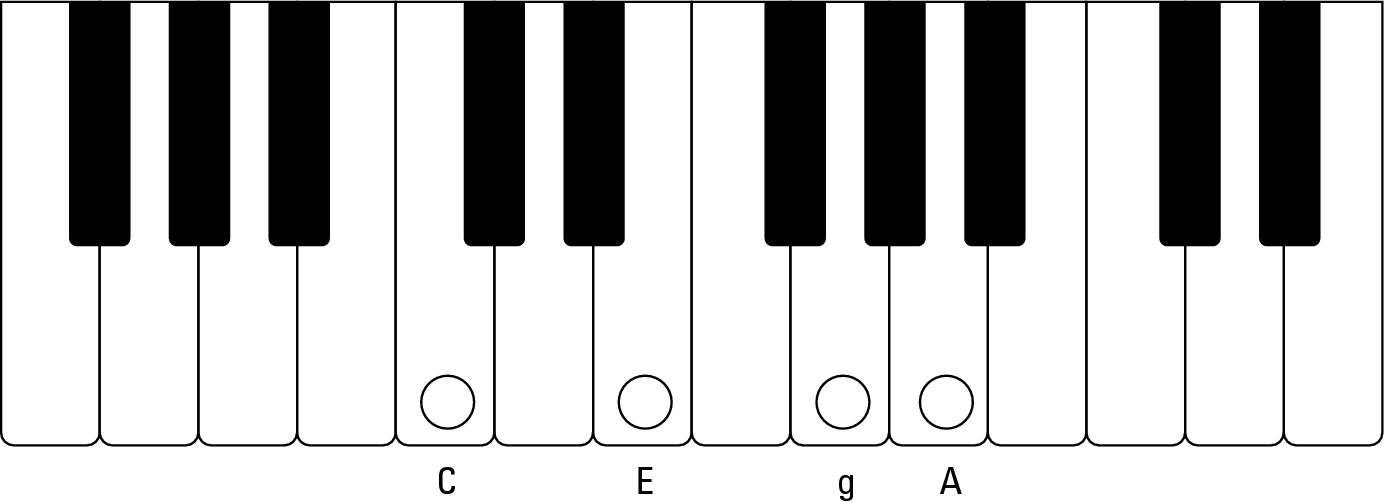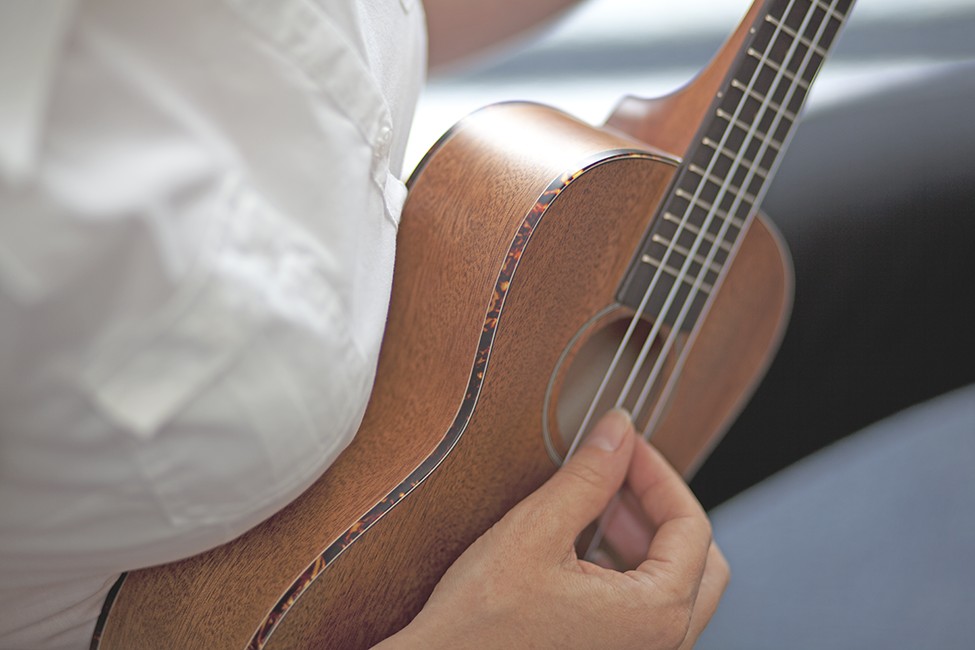Ukulele For Dummies (9 page)
Read Ukulele For Dummies Online
Authors: Alistair Wood

Although electronic tuners vary in their displays and modes, most are basically the same. Here's how to use one:
1. Clip the tuner onto the headstock of your ukulele and switch it on.
(Turn to Chapter 1 for a description of the headstock.)
2. If the tuner has different modes, choose the C mode.
3. Start by plucking the g-string (the first one, nearest your face).
You're aiming for the g note. If you've got an arrow display, when the arrow is pointing towards the left, you need to tune up. When the arrow points to the right, tune down.
4. When you get the arrow pointing straight up, you're in tune and you can repeat the process with the next string.
Not all electronic tuners work in the same way. Some use a system of lights (for example, red for too high/too low, green for in tune). The important thing is to make sure that you know which note you're tuning your string to. That's particularly important when you first get your ukulele, because often ukes are very out of tune when you buy them.
 Don't worry about getting everything dead-on. Some tuners are very sensitive. So long as you're close, you're going to be fine.
Don't worry about getting everything dead-on. Some tuners are very sensitive. So long as you're close, you're going to be fine.
Listening and repeating: Tuning to the audio track
 You can find tuning notes for gCEA tuning (with the tones in that order) in Track 1.
You can find tuning notes for gCEA tuning (with the tones in that order) in Track 1.
Listen to the first note played (a g) and play your open g-string (the first one) at the same time. You're aiming to get the two sounds exactly the same. Twist your uke's tuner to change the pitch of the string until the note on the track and the note on your ukulele sound exactly the same. Repeat the process for each string.
This process takes a bit of practice. Don't worry if you have to listen to the track a few times before you feel satisfied with your tuning.
 Tune up to a note rather than down to it. Tightening the string makes it less likely to slip. So if you find that your string sounds too high, tune it down so that it sounds lower than the note you're aiming for. Then tune up until the string is in tune.
Tune up to a note rather than down to it. Tightening the string makes it less likely to slip. So if you find that your string sounds too high, tune it down so that it sounds lower than the note you're aiming for. Then tune up until the string is in tune.
Stringing along: Tuning to a guitar
If you're playing with a guitarist, you want to make sure that you're in tune with each other. Otherwise you end up sounding like a back-alley banjo fight.
After the guitarist is in tune, ask him or her to play the following notes (note: guitarists can be easily bribed with âmagic beans'):
Ukulele | Guitar | |
g-string | = | E-string third fret |
C-string | = | B-string first fret |
E-string | = | E-string open |
A-string | = | E-string fifth fret |
Seeing in black and white: Tuning to a piano or keyboard
Pianos may not be the most glamorous instrument around, but they do come in handy. (That should guarantee the publisher some letters!) They hold their tuning much longer than most string instruments. Electronic keyboards are even better because their notes are produced digitally and are always spot-on.
So if you have a piano or keyboard handy, you have the perfect tuning source (note: unlike guitarists, pianists are above being bribed and so instead distract them with a particularly fascinating quadratic equation).
The C-string of a ukulele (the fattest one) equates to the middle C on a piano (slap bang in the middle of the keyboard â just to the left of two black keys next to each other). Two white keys up from the C is E. Up two more white keys to G and up to the next white key for A. (See Figure 2-3.)
Figure 2-3:
Finding the right notes on a piano or keyboard.

Tuning your uke to itself
If you're stuck with nothing to help you tune, you can always tune the ukulele with itself. This method is the trickiest, however, and so get comfortable with a couple of the other methods (described in the preceding sections) before attempting it. Practising this method of tuning is well worthwhile, though, because you never know when you're going to get caught without a tuner or other instrument.
You can start with the C-string (the third one up) because it tends to hold its tuning best:
1. Play the C-string at the fourth fret and pluck it.
(Check out Chapter 4 for more on fretting.)
2. Now play the open E-string (the third one) and compare the sounds.
When you're in tune, these notes sound the same. If the E-string is too low, tune it up a little (or if it's too high, tune down), and then try again. Repeat the process until both strings sound the same.
3. Play the E-string at the third fret and then the open g-string (the first one).
Adjust that string until it's in tune.
4. Play the E-string at the fifth fret and tune the A-string (the fourth one) to that note.
New ukulele strings slip out of tune very quickly. When they are put on the uke they stretch a little and lose their tuning. A period of two weeks or more is needed before they
bed-in
(that is, stop stretching and stay in tune longer).
 You can speed this bedding-in process up by stretching the strings. Tune your ukulele, pull one string away from the soundhole and gently tug it a few times. Play the string again and it'll probably be out of tune. Tune it up and repeat the process. The string should be less out of tune each time you try it. Do this with each string and your ukulele should stay in tune better.
You can speed this bedding-in process up by stretching the strings. Tune your ukulele, pull one string away from the soundhole and gently tug it a few times. Play the string again and it'll probably be out of tune. Tune it up and repeat the process. The string should be less out of tune each time you try it. Do this with each string and your ukulele should stay in tune better.
Chapter 3
Discovering How to Handle Your Ukulele
In This Chapter
 Getting a grip on your uke
Getting a grip on your uke
 Preparing to strum
Preparing to strum
 Fretting without worrying
Fretting without worrying
A
ny idiot knows that you hold the ukulele in front of you and hit the strings. Even Tiny Tim figured that much out. So who needs a whole chapter about that stuff? Well, everybody. The position of your hands, arms and entire body can change how hard the ukulele is to play and the sound you make. Seemingly small things can have a big impact on the way you play, and so this chapter tells you all about positioning yourself and holding your ukulele.
Picking up good habits is just as easy as picking up bad ones. You're sure to be glad in the future that you got the fundamentals under your belt now, and you're going to save yourself a lot of time otherwise spent trying to get rid of bad habits.
Holding On to Your Ukulele
No, this section isn't about not getting your uke stolen, but instead shows that the way you hold a ukulele is a vitally important part of making it sound good. The uke is such a small instrument that choking all the sound out of it is all too easy.
Here's a general guide to holding your ukulele: try to touch it as little as possible. By this advice I mean that you want to make as little contact as you can manage without sending your ukulele crashing to the ground and exploding into hundreds of pieces.
 Watch professional ukulele players and how they hold their instruments. Search out DVDs of Jake Shimabukuro and Roy Smeck for a masterclass in holding the ukulele.
Watch professional ukulele players and how they hold their instruments. Search out DVDs of Jake Shimabukuro and Roy Smeck for a masterclass in holding the ukulele.
Positioning yourself to play
When you're playing, you have three main points of contact with the uke:
 The back of the ukulele against your body (see Figure 3-1).
The back of the ukulele against your body (see Figure 3-1).
 Your forearm on the front of the ukulele just behind the bridge (positioned so that your hand falls naturally over the part where the body meets the neck).
Your forearm on the front of the ukulele just behind the bridge (positioned so that your hand falls naturally over the part where the body meets the neck).
 The underside of the ukulele neck against the crook of your hand (between your thumb and index finger; see Figure 3-2).
The underside of the ukulele neck against the crook of your hand (between your thumb and index finger; see Figure 3-2).
Figure 3-1:
Holding the ukulele against your body (strumming arm).

 Don't smother the ukulele by holding it tightly into your chest because that kills the volume and the tone.
Don't smother the ukulele by holding it tightly into your chest because that kills the volume and the tone.
Instead, angle the ukulele away from your body as in Figure 3-2 (so that the headstock is farther away from you than the ukulele's body; check out Chapter 1 for a list of the names of the various parts of your uke). This positioning creates air around the back of the uke, giving it room to breathe and pump out some volume.
Figure 3-2:
Holding the ukulele in the crook of your fretting hand.

Standing up
Holding the ukulele while standing up can be something of a juggling act. Each of the three points of contact mentioned in the preceding section has to be stronger than when you're sitting down.
Also, you may have to change the balance of the three points. For example, when you're playing a tricky section with your fretting hand, it can't hold the neck as firmly and you have to support the uke more strongly with your strumming arm.
 The smaller your ukulele is, the easier you're going to find holding it. If you're playing a tenor ukulele, you may want to use a strap (Chapter 1 describes the different sizes of ukulele). A strap offers some definite advantages: it frees up both your strumming and fretting hands to concentrate on playing, which means that you can play technical passages more easily.
The smaller your ukulele is, the easier you're going to find holding it. If you're playing a tenor ukulele, you may want to use a strap (Chapter 1 describes the different sizes of ukulele). A strap offers some definite advantages: it frees up both your strumming and fretting hands to concentrate on playing, which means that you can play technical passages more easily.
